Traffic and Climate Impacts on Rutting and Thermal Cracking in Flexible and Composite Pavements
Abstract
:1. Introduction
2. Significance of the Study
3. Background
3.1. SPS-3
3.2. SPS-6
3.3. GPS-6B
4. Pavement Test Sections
4.1. Locations
4.2. Structural Cross-Sections
4.2.1. New York (NY) Sections
4.2.2. California (CA) Sections
4.2.3. Comparison of New York (NY) and California (CA) Sections
4.3. Traffic Loading
4.4. Climate Conditions
4.5. Maintenance History
5. In-State Analysis
5.1. New York (NY) Sections (36-1643 and 36-A350)
5.2. California (CA) Sections (06-0603 and 06-0606)
6. Cross-State Analysis
6.1. Low-Structural Capacity Sections (06-0606 and 36-A350)
6.2. High-Structural Capacity Sections (06-0603 and 36-1643)
7. Deterioration Models
8. Conclusions
- The chip seal layer laid with a thickness of 0.8” (20.4 mm) showed low resistance to thermal cracking and rutting compared to the thin AC overlay;
- The pavement section treated with a thin AC overlay had 0.07” (1.8 mm) of rutting after the first year of service, but the deterioration rate was low compared to the pavement section treated with a chip seal layer.
- Structural capacity had an insignificant impact on the thermal cracking in the pavement sections;
- The additional 1.5” (38.3 mm) thickness of the AC layer resulted in a significant decrease in the rutting depth because of the lower rutting progression.
- A wet and freezing climate contributed to a higher degree of thermal cracking in the pavement section;
- The chip seal layer had low resistance to thermal cracking, even when subjected to low traffic loads;
- The ability of the chip seal layer to resist rutting was limited, even in a wet, freezing climate zone.
- Despite being subjected to higher truck loads (AADTT), the pavement section in the non-freezing climate zone exhibited slightly lower thermal cracking than the pavement section in the freezing climate zone;
- The rutting resistance of the pavement sections in freezing and non-freezing climate zones was comparable with an insignificant difference, as confirmed by the result of the statistical t-test.
Author Contributions
Funding
Institutional Review Board Statement
Informed Consent Statement
Data Availability Statement
Acknowledgments
Conflicts of Interest
References
- Bhandari, S.; Luo, X.; Wang, F. Understanding the effects of structural factors and traffic loading on flexible pavement performance. Int. J. Transp. Sci. Technol. 2022; in press. [Google Scholar] [CrossRef]
- Gudipudi, P.; Underwood, S.; Zalghout, A. Impact of climate change on pavement structural performance in the United States. Transp. Res. D Transp. Environ. 2017, 57, 172–184. [Google Scholar] [CrossRef]
- Tamrakar, N.K. Overview on causes of flexible pavement distresses. Bull. Nepal Geol. Soc. 2019, 36, 245–250. [Google Scholar]
- Sarireh, M.K. Flexible pavement distress evaluation and analysis. Int. J. Adv. Res. Eng. 2016, 2, 1–7. [Google Scholar]
- Erlingsson, S. Rutting development in a flexible pavement structure. Road Mater. Pavement Des. 2012, 13, 218–234. [Google Scholar] [CrossRef]
- Safiuddin, M.; Tighe, S.L.; Uzarowski, L. Evaluation of stiffness to predict rutting resistance of hot-mix asphalt: A Canadian case study. Balt. J. Road Bridge Eng. 2014, 9, 283–296. [Google Scholar] [CrossRef]
- Ahmad, J.; Rahman, M.Y.A.; Hainin, M.R. Rutting evaluation of dense graded hot mix asphalt mixture. Int. J. Eng. Technol. 2011, 11, 56–60. [Google Scholar]
- Hu, S.; Zhou, F.; Scullion, T. Development, calibration, and validation of a new M-E rutting model for HMA overlay design and analysis. J. Mater. Civ. 2011, 23, 89–99. [Google Scholar] [CrossRef]
- Abdallah, I.; Nazarian, S. Strategies to Improve and Preserve Flexible Pavement at Intersections; FHWA/TX 10/0-5566-1; Center for Transportation Infrastructure Systems, the University of Texas at El Paso: El Paso, TX, USA, 2011. [Google Scholar]
- Federal Highway Administration (FHWA). Climate Change Adaptation for Pavements; FHWA-HIF-15-015; FHWA Office of Asset Management, Pavements and Construction, USA Department of Transportation: Washington, DC, USA, 2015.
- Ghos, S.; Ali, S.A.; Zaman, M.; Chen, D.H.; Hobson, K.; Behm, M. Evaluation of transverse cracking in flexible pavements using field investigation and AASHTOWare pavement ME design. Int. J. Pavement Res. Technol. 2021, 15, 561–576. [Google Scholar] [CrossRef]
- Mastin, N. NCDOT Digital Imagery Distress Evaluation Handbook; Version 1.0; Pavement Management Unit, North Carolina Department of Transportation: Raleigh, NC, USA, 2011.
- Ahmad, T.; Khawaja, H. Review of low-temperature crack (LTC) developments in asphalt pavements. Int. J. Multiphysics 2018, 12, 169–188. [Google Scholar]
- Ambaiowei, D.C.; Sanchez, X.; Safiuddin, M.; Tighe, S.L. Investigating thermal cracking potential of RAP incorporated HMA mixtures. In Proceedings of the 2013 TAC Conference, Winnipeg, MB, Canada, 22–25 September 2013. [Google Scholar]
- European Commission. COST 324: Long Term Performance of Pavements; Final Report (ISBN 92-828-0308-2); Publications Office of European Union: Luxembourg, 1997. [Google Scholar]
- European Commission. COST 333: Development of New Bituminous Pavement Design Method; Final Report (ISBN 92-828-6796-X); Publications Office of European Union: Luxembourg, 1999. [Google Scholar]
- Ling, M.; Luo, X.; Chen, Y.; Hu, S.; Lytton, R.L. A calibrated mechanics-based model for top-down cracking of asphalt pavements. Constr. Build. Mater. 2019, 208, 102–112. [Google Scholar] [CrossRef]
- Hernando, D.; Del Val, M.A. A comprehensive overview on main distress mechanisms in composite pavements. Int. J. Pavement Res. Technol. 2013, 6, 737–744. [Google Scholar]
- Von Quintus, H.L.; Finn, F.N.; Hudson, W.R.; Roberts, F.L. Flexible and Composite Structures for Premium Pavements: Vol. 1–Development of Design Procedure; FHWA-RD-81-154; Federal Highway Administration: Washington, DC, USA, 1979.
- National Cooperative Highway Research Program. Guide for Mechanistic-Empirical Design of New and Rehabilitated Pavement Structures; NCHRP 1-37A; Transportation Research Board: Washington, DC, USA, 2004. [Google Scholar]
- Flintsch, G.W.; Diefenderfer, B.K.; Nunez, O. Composite Pavement Systems: Synthesis of Design and Construction Practices; FHWA/VTRC 09-CR2; Virginia Transportation Research Council: Charlottesville, VA, USA, 2008. [Google Scholar]
- Fang, X. Development of Distress and Performance Models of Composite Pavements for Pavement Management. Doctoral Dissertation, The University of North Carolina at Charlotte, Charlotte, NC, USA, 2017. [Google Scholar]
- Piryonesi, S.M.; El-Diraby, T. Data analytics in asset management: Cost-effective prediction of the pavement condition index. J. Infrastruct. Syst. 2020, 26, 04019036. [Google Scholar] [CrossRef]
- Piryonesi, S.M.; El-Diraby, T. Climate change impact on infrastructure: A machine learning solution for predicting pavement condition index. Constr. Build. Mater. 2021, 306, 124905. [Google Scholar] [CrossRef]
- Gong, H.; Sun, Y.; Shu, X.; Huang, B. Use of random forests regression for predicting IRI of asphalt pavements. Constr. Build. Mater. 2018, 189, 890–897. [Google Scholar] [CrossRef]
- Piryonesi, S.M.; El-Diraby, T. Using machine learning to examine impact of type of performance indicator on flexible pavement deterioration modeling. J. Infrastruct. Syst. 2021, 27, 04021005. [Google Scholar] [CrossRef]
- Federal Highway Administration (FHWA). Long Term Pavement Performance Program: Accomplishments and Benefits 1989–2009; FHWA-HRT-10-071; Turner Fairbank Highway Research Center: McLean, VA, USA, 2009.
- Federal Highway Administration (FHWA). Results of Long-Term Pavement Performance SPS-3 Analysis: Preventive Maintenance of Flexible Pavements; FHWA-HRT-11-049; Turner-Fairbank Highway Research Center: McLean, VA, USA, 2011.
- Morian, D.A.; Gibson, S.D.; Epps, J.A. Maintaining Flexible Pavements—The Long-Term Pavement Performance Experiment SPS-3: 5-Year Data Analysis; FHWA-RD-97-102; Turner-Fairbank Highway Research Center: McLean, VA, USA, 1998.
- Federal Highway Administration (FHWA). SPS-6: Rehabilitation of Jointed Portland Cement Concrete Pavements: Construction Report; FHWA-AZ92-379-II; Arizona Department of Transportation: Phoenix, AZ, USA, 1992.
- Hall, K.T.; Correa, C.E.; Simpson, A.L. LTPP Data Analysis: Effectiveness of Maintenance and Rehabilitation Options; NCHRP Web Document 47 (Project 20-50(3/4)); National Cooperative Highway Research Program: Washington, DC, USA, 2002.
- Elkins, G.E.; Thompson, T.; Simpson, A.; Ostrom, B. Long-Term Pavement Performance Information Management System Pavement Performance Database User Reference Guide; FHWA-RD-03-088; Turner-Fairbank Highway Research Center: McLean, VA, USA, 2012.
- LTPP InfoPave. U.S. Department of Transportation, Federal Highway Administration; Turner-Fairbank Highway Research Center: McLean, VA, USA. Available online: https://infopave.fhwa.dot.gov/ (accessed on 31 July 2017).
- Weather Underground. The Weather Company, Brookhaven, GA, USA. Available online: https://www.wunderground.com (accessed on 31 July 2017).
- Pavement Interactive. Freezing and Thawing Indexes. Available online: http://www.pavementinteractive.org/calculation-offrost-depth/ (accessed on 31 July 2017).
- Mahoney, J.P.; Rutherford, M.S.; Hicks, R.G. Guidelines for Spring Highway Use Restrictions; FHWA-TS-87-209; Turner-Fairbank Highway Research Center: McLean, VA, USA, 1987.
- Naiel, K. Flexible Pavement Rut Depth Modeling for Different Climate Zones. Ph.D. Thesis, Department of Civil and Environmental Engineering, Wayne State University, Detroit, MI, USA, 2010. [Google Scholar]
- Wang, H.; Zhou, Z.; Huang, W.; Dong, X. Investigation of asphalt mixture permanent deformation based on three-dimensional discrete element method. Constr. Build. Mater. 2021, 272, 121808. [Google Scholar] [CrossRef]
- Drakos, C.A.; Roque, R.; Birgisson, B. Effects of measured tire contact stresses on near-surface rutting. Transp. Res. Rec. 2001, 1764, 59–69. [Google Scholar] [CrossRef]
- Novak, M.; Birgisson, B.; Roque, R. Tire contact stresses and their effects on instability rutting of asphalt mixture pavements. Transp. Res. Rec. 2003, 1853, 150–156. [Google Scholar] [CrossRef]
- Zhang, W. Evaluation of Field Transverse Cracking of Asphalt Pavements. Ph.D. Thesis, Department of Civil and Environmental Engineering, Washington State University, Pullman, WA, USA, 2015. [Google Scholar]
- Nesnas, K.; Nunn, M. A model for top-down reflection cracking in composite pavements. In Proceedings of the Fifth International RILEM Conference on Reflective Cracking in Pavements, Limoges, France, 5 May 2004; pp. 409–416. [Google Scholar]
- Bennert, T.; Worden, M.; Turo, M. Field and laboratory forensic analysis of reflective cracking on Massachusetts Interstate 495. Transp. Res. Rec. 2009, 2126, 27–38. [Google Scholar] [CrossRef]
- Shen, S.H.; Zhang, W.G.; Wang, H.; Huang, H. Numerical evaluation of surface-initiated cracking in flexible pavement overlays with field observations. Road Mater. Pavement Des. 2016, 18, 221–234. [Google Scholar] [CrossRef]
- Zhang, W.; Khan, A.R.; Shen, S.; Gao, Y. Laboratory validation of surface-initiated transverse cracking of asphalt pavement. Appl. Sci. 2020, 10, 1002. [Google Scholar] [CrossRef] [Green Version]
- Kandhal, P.; Cooley, L.A., Jr. Accelerated Laboratory Rutting Tests: Evaluation of the Asphalt Pavement Analyzer; NCHRP Report 508; Transportation Research Board: Washington, DC, USA, 2003. [Google Scholar]
- Hair, J.F., Jr.; Hult, G.T.M.; Ringle, C.M.; Sarstedt, M.; Danks, N.P.; Ray, S. Partial Least Squares Structural Equation Modeling (PLS-SEM) Using R; Springer: Cham, Switzerland, 2021. [Google Scholar]
- Hair, J.F.; Sarstedt, M. Explanation plus prediction—The logical focus of project management research. Proj. Manag. J. 2021, 52, 319–322. [Google Scholar] [CrossRef]
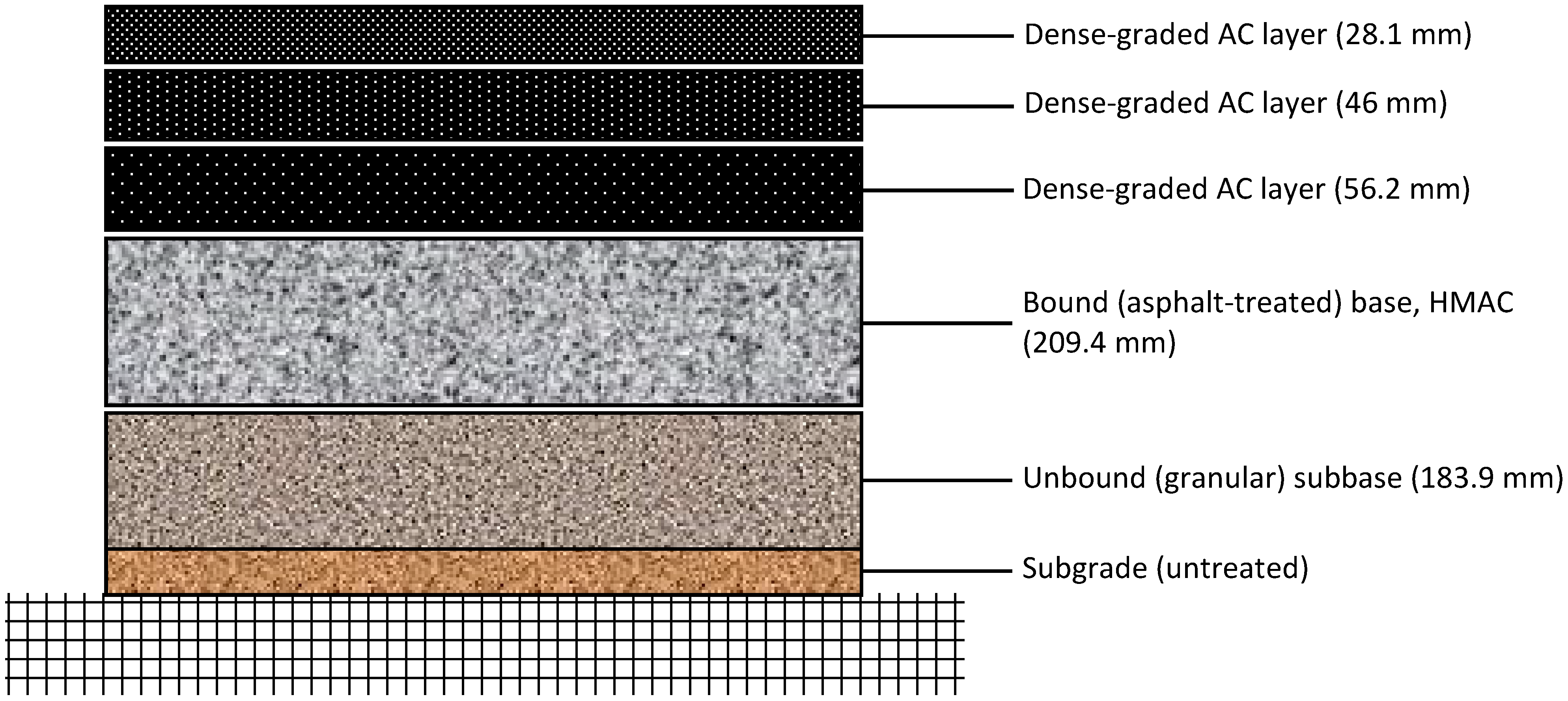
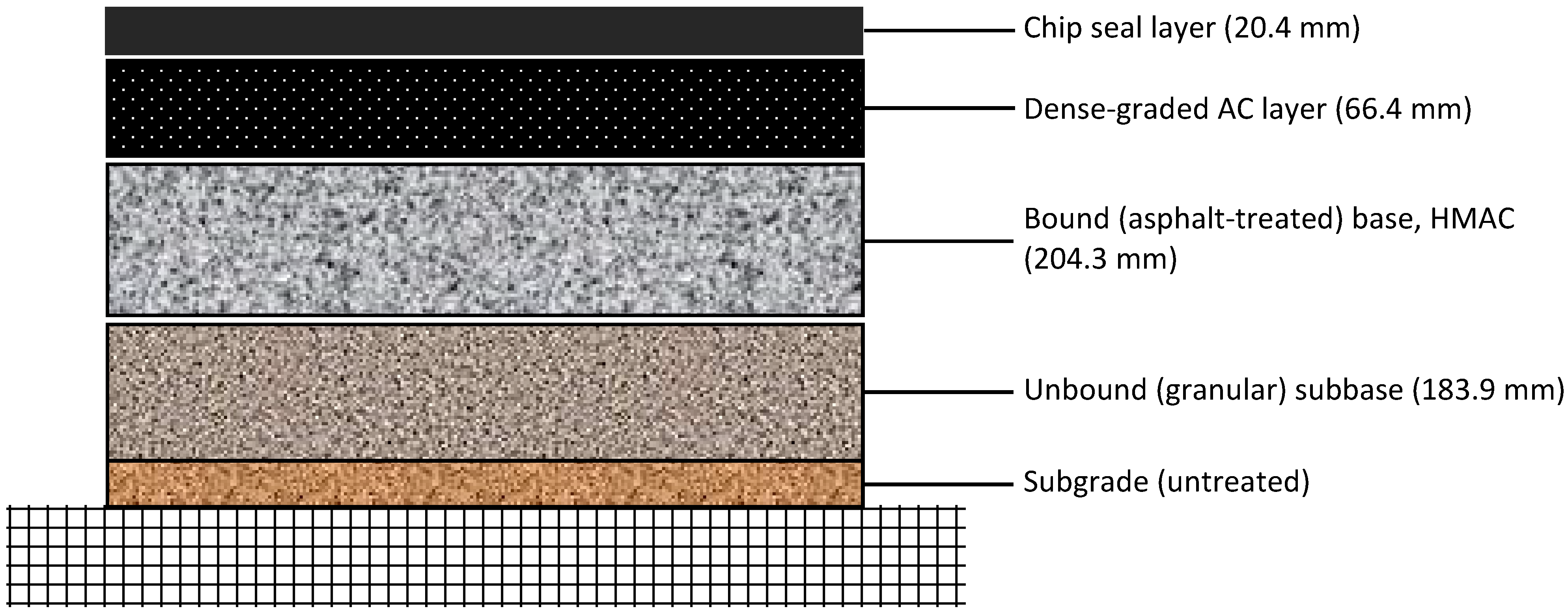
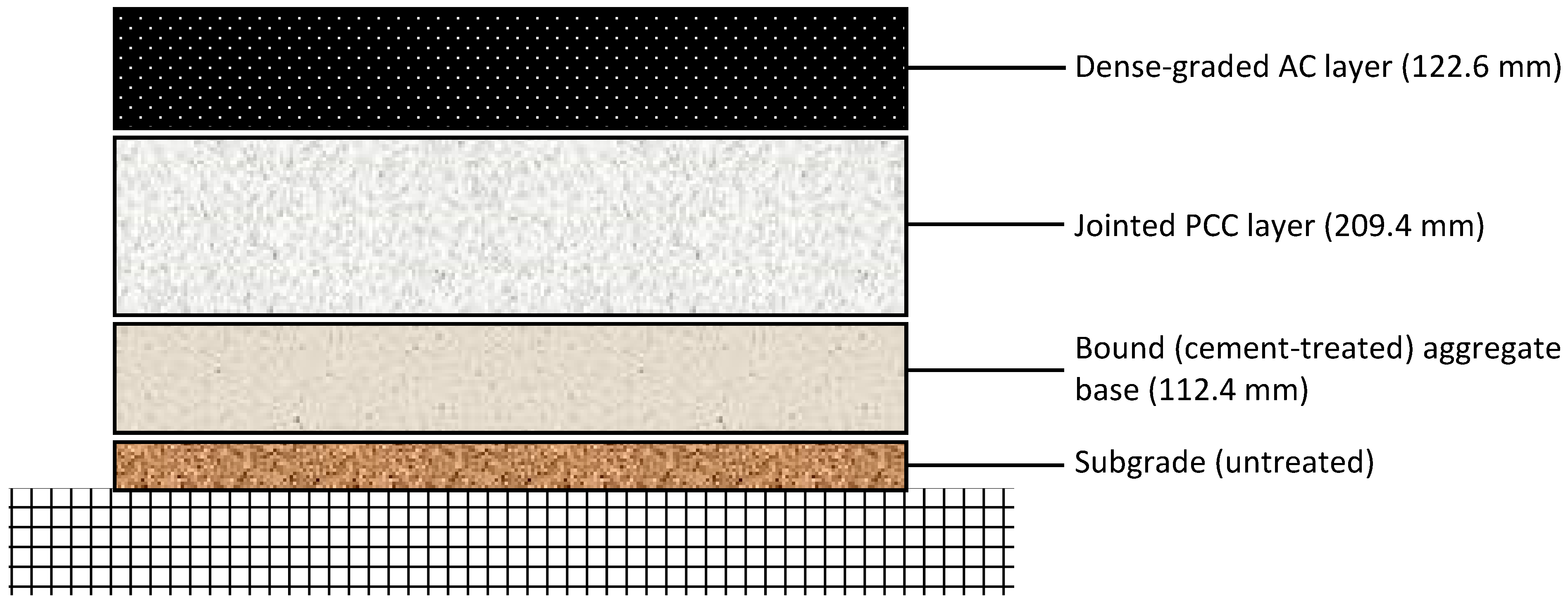

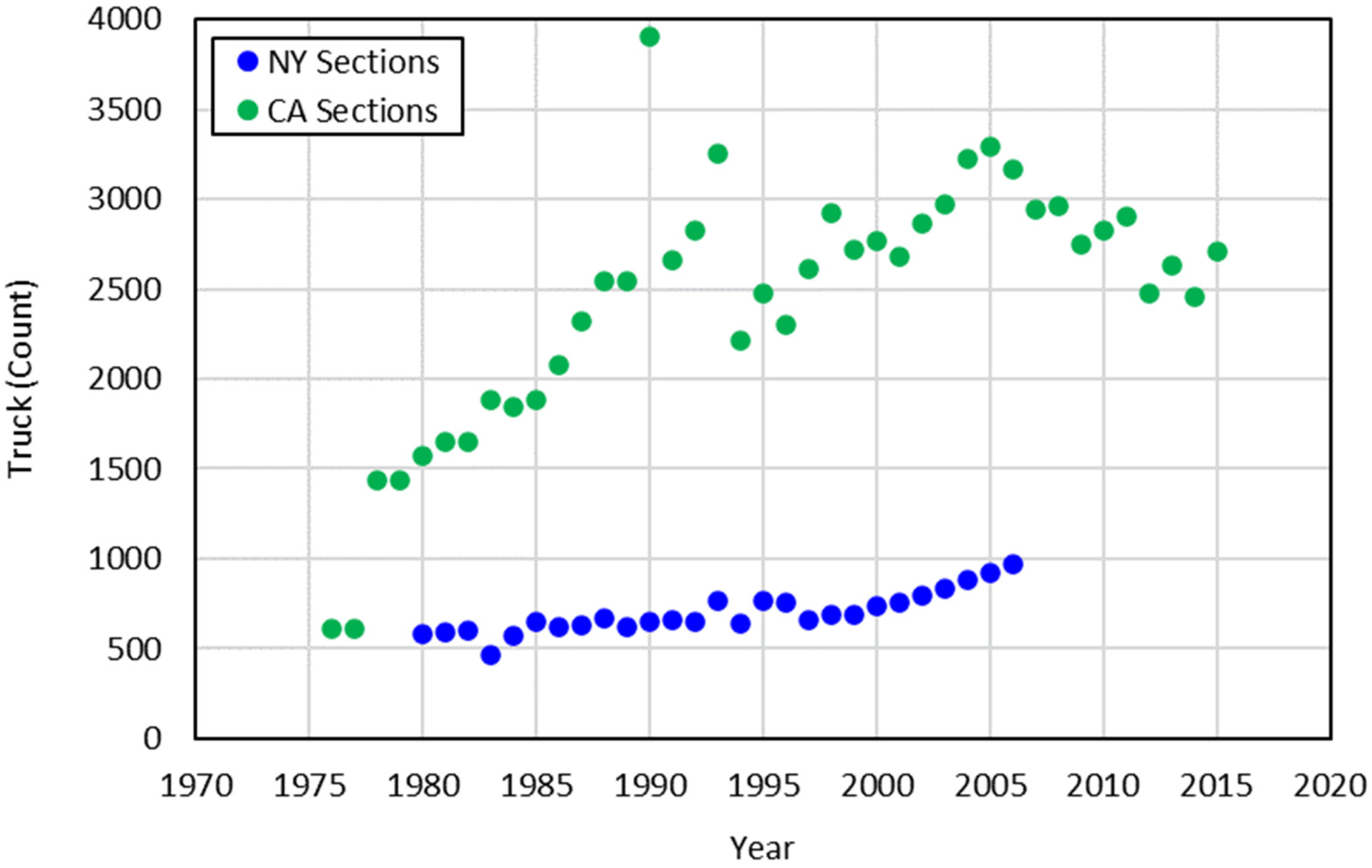
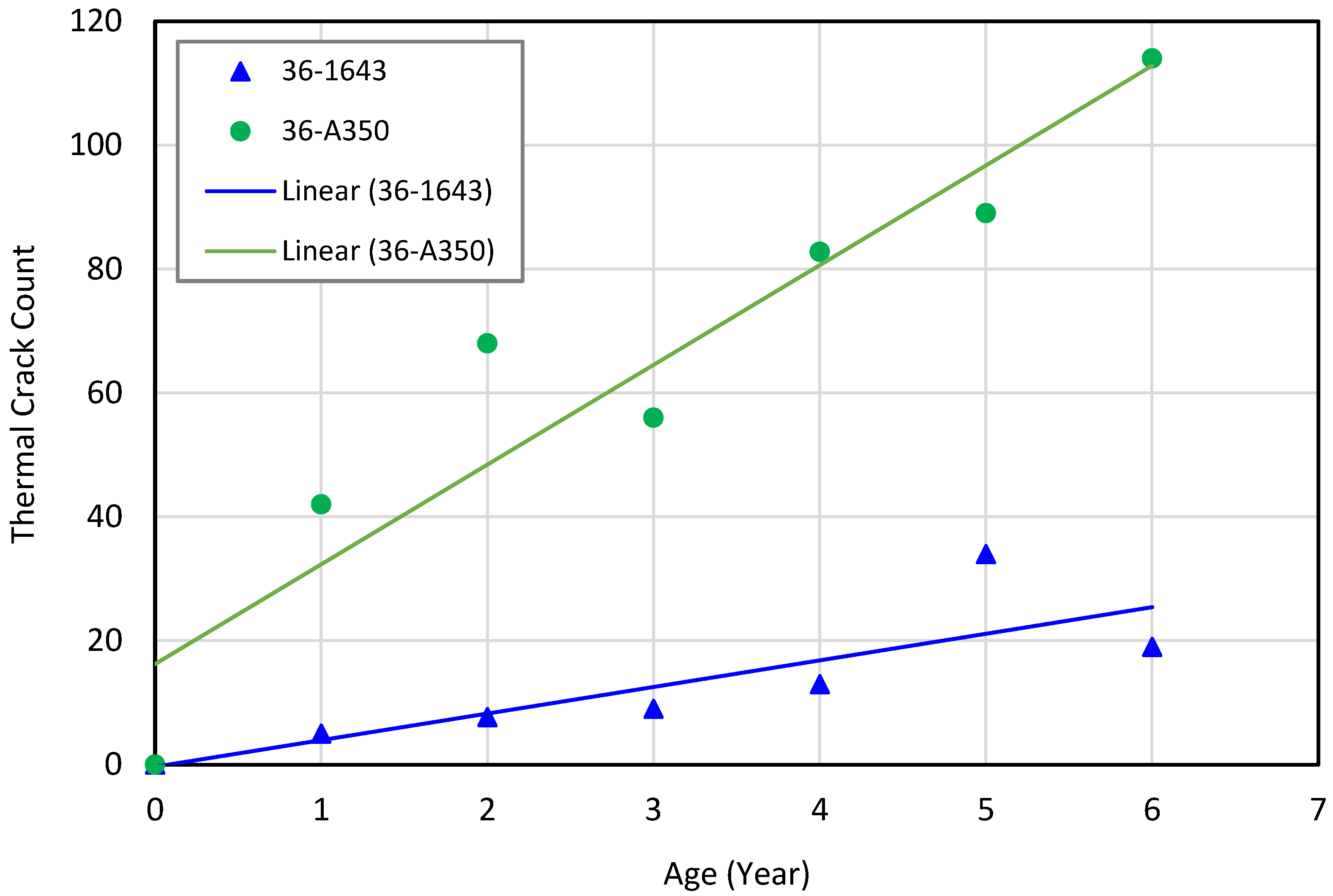
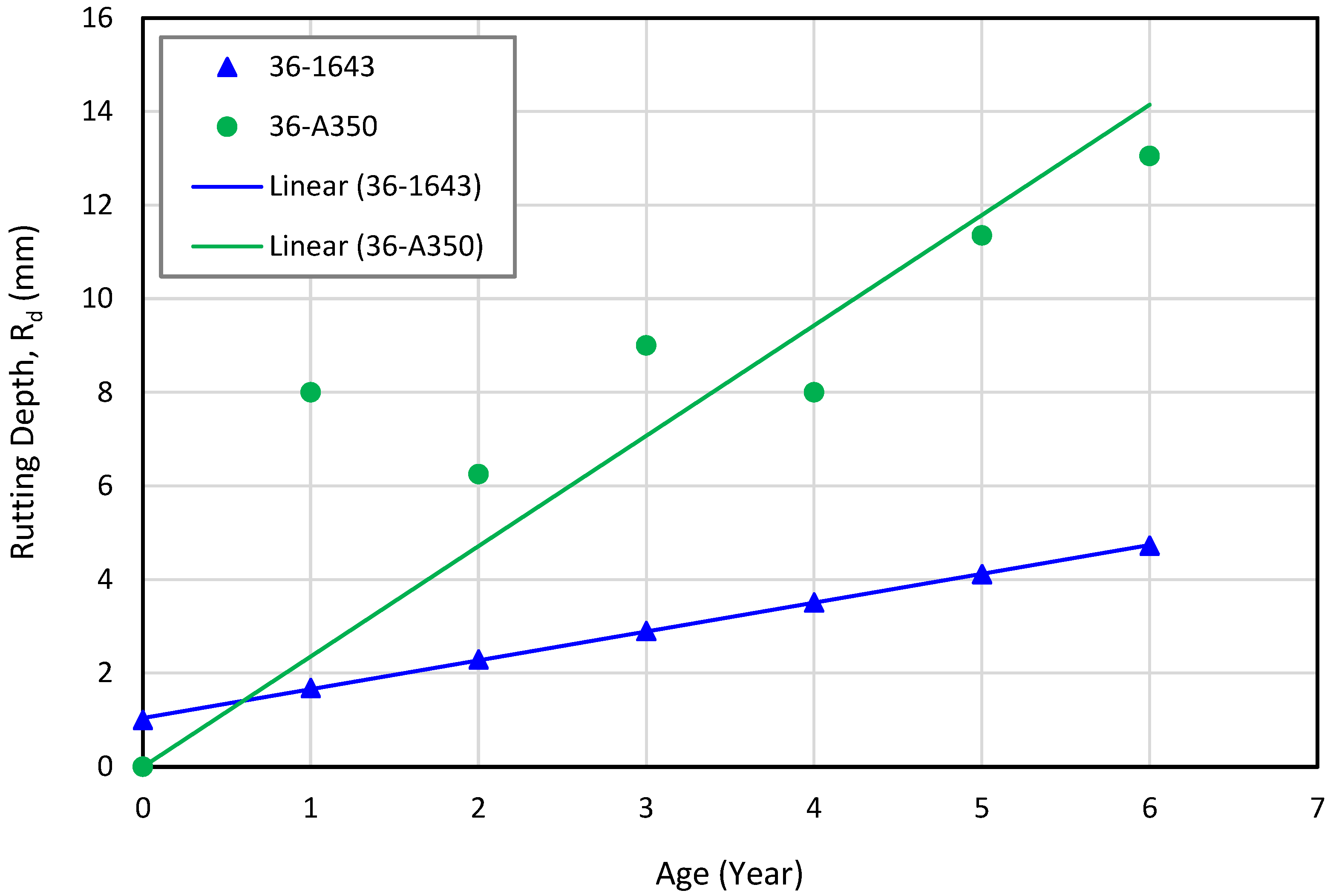

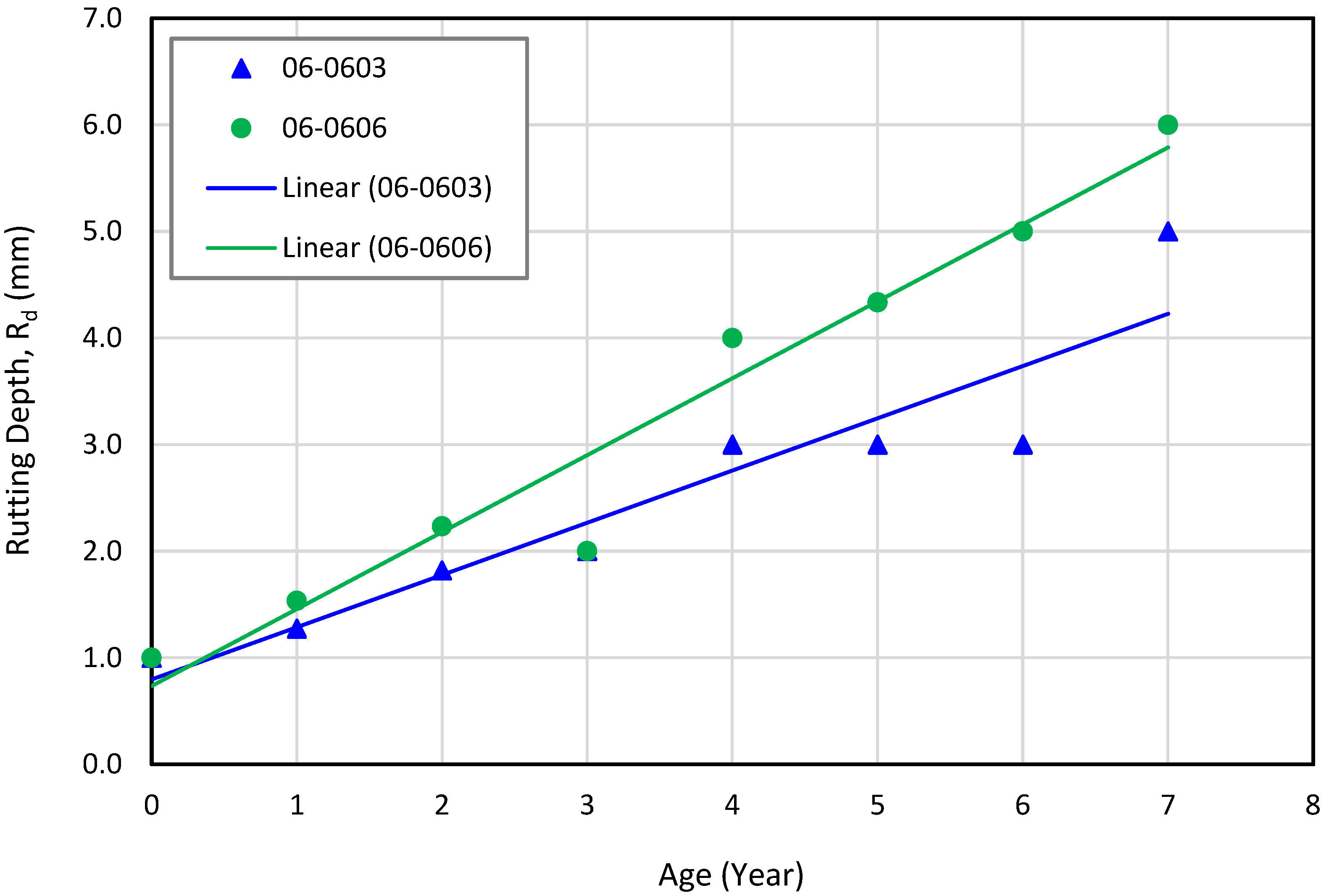

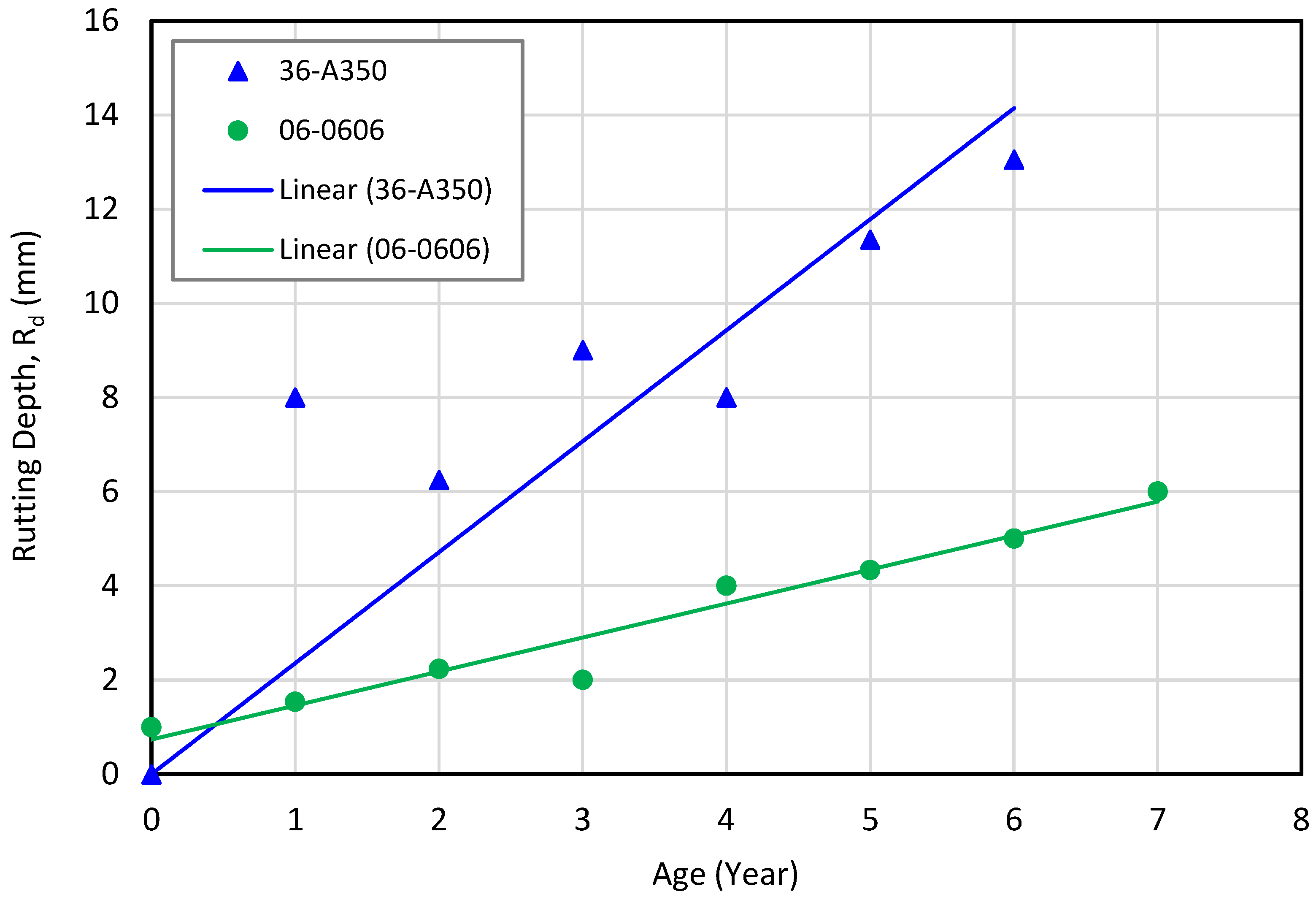

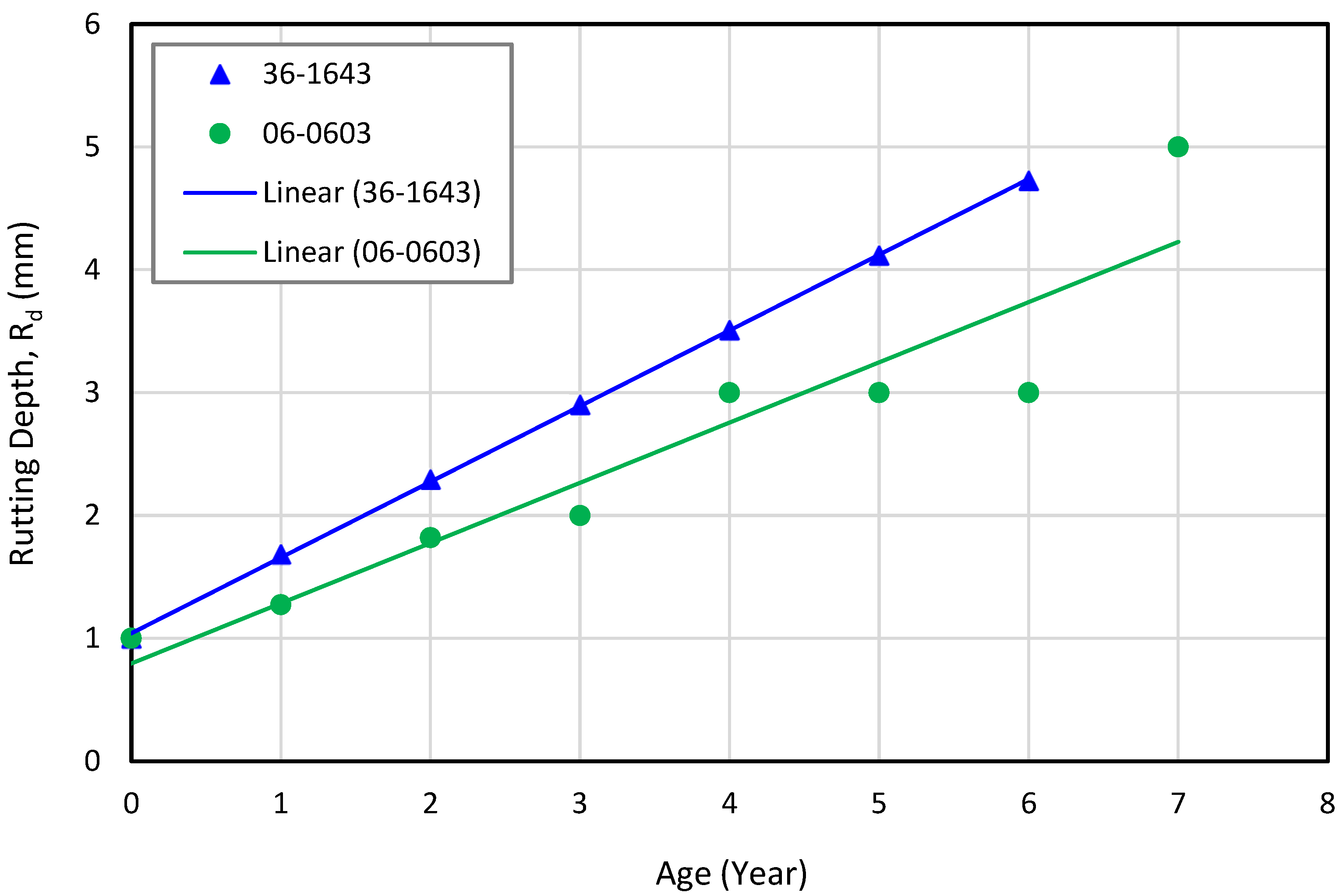
| Year | Annual Average Temperature * (°C) | Annual Average Freezing Index (°C-day) | ||
|---|---|---|---|---|
| NY Sections | CA Sections | NY Sections | CA Sections | |
| 1973 | - | 9.9 | - | 52 |
| 1974 | - | 9.7 | - | 115 |
| 1975 | - | 8.8 | - | 84 |
| 1976 | - | 9.4 | - | 44 |
| 1977 | - | 9.3 | - | 89 |
| 1978 | 6.9 | 9.1 | 822 | 89 |
| 1979 | 8.1 | 9.4 | 669 | 83 |
| 1980 | 7.3 | 9.7 | 746 | 34 |
| 1981 | 8.2 | 10.4 | 614 | 4 |
| 1982 | 7.4 | 8.5 | 767 | 100 |
| 1983 | 8.6 | 9.3 | 492 | 20 |
| 1984 | 8.5 | 9.5 | 495 | 55 |
| 1985 | 8.0 | 9.4 | 646 | 89 |
| 1986 | 8.2 | 10.4 | 571 | 8 |
| 1987 | 7.9 | 11.0 | 624 | 51 |
| 1988 | 8.0 | 10.5 | 625 | 61 |
| 1989 | 7.9 | 9.4 | 769 | 102 |
| 1990 | 9.5 | 9.5 | 295 | 156 |
| 1991 | 9.2 | 10.3 | 463 | 11 |
| 1992 | 7.6 | 10.8 | 523 | 34 |
| 1993 | 7.8 | 9.2 | 679 | 97 |
| 1994 | 7.7 | 9.8 | 807 | 47 |
| 1995 | 8.5 | 10.3 | 559 | 7 |
| 1996 | 8.0 | 10.1 | 605 | 38 |
| 1997 | 7.8 | 9.9 | 502 | 48 |
| 1998 | 9.9 | 9.1 | 300 | 81 |
| 1999 | 9.3 | 9.7 | 472 | 28 |
| 2000 | 8.2 | 10 | 592 | 15 |
| 2001 | 9.3 | 10.3 | 386 | 53 |
| 2002 | 9.5 | 10.2 | 286 | 55 |
| 2003 | 7.9 | 10.6 | 768 | 20 |
| 2004 | 8.3 | 10.2 | 701 | 30 |
| 2005 | 9.3 | 10.1 | 629 | 44 |
| 2006 | 9.2 | 9.9 | 273 | 70 |
| 2007 | 6.6 | 10.2 | 783 | 84 |
| 2008 | 7.9 | 10.1 | 672 | 106 |
| 2009 | 8.0 | 10.5 | 659 | 64 |
| 2010 | 9.6 | 10.0 | 425 | 22 |
| 2011 | 9.4 | 9.9 | 535 | 26 |
| 2012 | 10.6 | 10.6 | 226 | 50 |
| State | Pavement Section | Distress | Developed Model | Coefficient of Determination (r2) | Standard Error (SE) |
|---|---|---|---|---|---|
| CA | 06-0603 | Rutting | Rd = 0.398 Age + 0.0012 AADTT − 1.98 | 0.89 | 0.51 |
| CA | 06-0606 | Rutting | Rd = 0.412 Age + 0.0042 AADTT − 8.58 | 0.92 | 0.29 |
| CA | 06-0603 | Thermal cracking | Ctc = 4.606 Age + 0.0541 AADTT + 40.09 FI − 140.11 | 0.90 | 9.92 |
| CA | 06-0606 | Thermal cracking | Ctc = 4.39 Age + 0.0469 AADTT − 24.68 FI − 102.68 | 0.98 | 3.54 |
| NY | 36-1643 | Rutting | Rd = 0.623 Age − 0.0001 AADTT + 1.44 | 0.99 | 0.01 |
| NY | 36-A350 | Rutting | Rd = −1.041 Age + 0.0035 AADTT − 7.56 | 0.84 | 0.96 |
| NY | 36-1643 | Thermal cracking | Ctc = 2.894 Age − 0.0099 AADTT + 0.41 FI + 50.56 | 0.82 | 6.71 |
| NY | 36-A350 | Thermal cracking | Ctc = 20.797 Age + 0.0055 AADTT − 0.91 FI − 8.36 | 0.97 | 9.14 |
Publisher’s Note: MDPI stays neutral with regard to jurisdictional claims in published maps and institutional affiliations. |
© 2022 by the authors. Licensee MDPI, Basel, Switzerland. This article is an open access article distributed under the terms and conditions of the Creative Commons Attribution (CC BY) license (https://creativecommons.org/licenses/by/4.0/).
Share and Cite
Raffaniello, A.; Bauer, M.; Safiuddin, M.; El-Hakim, M. Traffic and Climate Impacts on Rutting and Thermal Cracking in Flexible and Composite Pavements. Infrastructures 2022, 7, 100. https://doi.org/10.3390/infrastructures7080100
Raffaniello A, Bauer M, Safiuddin M, El-Hakim M. Traffic and Climate Impacts on Rutting and Thermal Cracking in Flexible and Composite Pavements. Infrastructures. 2022; 7(8):100. https://doi.org/10.3390/infrastructures7080100
Chicago/Turabian StyleRaffaniello, Alexa, Matthew Bauer, Md. Safiuddin, and Mohab El-Hakim. 2022. "Traffic and Climate Impacts on Rutting and Thermal Cracking in Flexible and Composite Pavements" Infrastructures 7, no. 8: 100. https://doi.org/10.3390/infrastructures7080100
APA StyleRaffaniello, A., Bauer, M., Safiuddin, M., & El-Hakim, M. (2022). Traffic and Climate Impacts on Rutting and Thermal Cracking in Flexible and Composite Pavements. Infrastructures, 7(8), 100. https://doi.org/10.3390/infrastructures7080100







